Prepare Your Org for Service Innovations
Learning Objectives
After completing this unit, you’ll be able to:
- Describe how the Service Innovations console facilitates your service experience.
- Outline the steps for Computer Telephony Integration (CTI) enablement.
- Describe the objects in the Engagement data model.
- Configure Identity Verification.
Follow the Steps of a Service Agent
Cindy wants to understand what a service workflow looks like using the Service Innovations console.
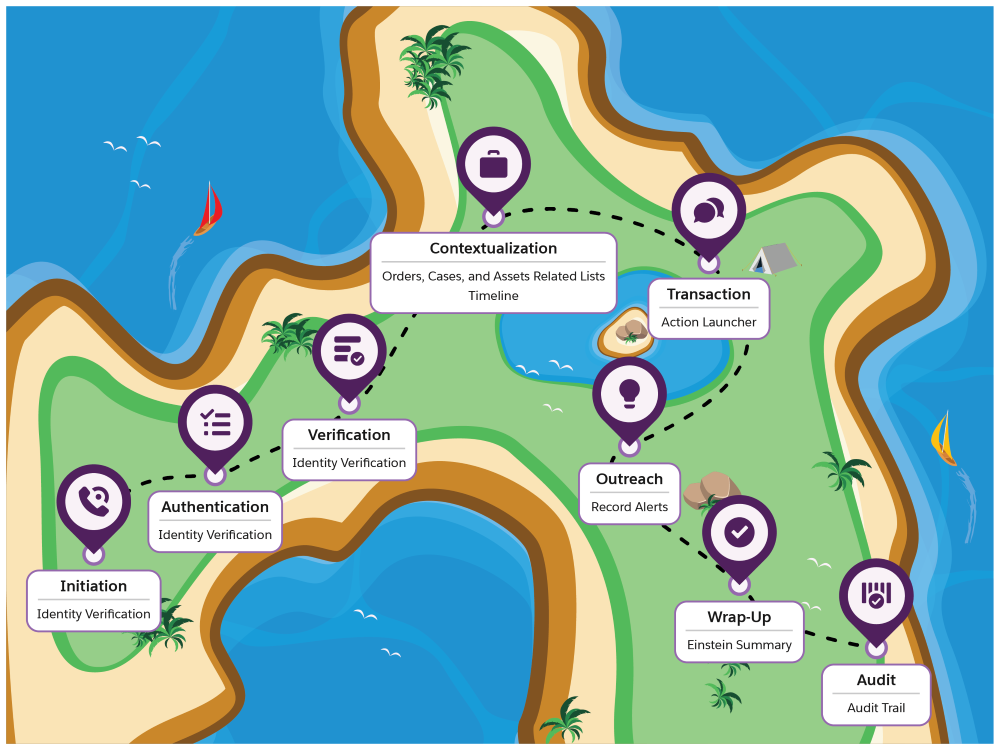
Here’s what she learns.
Initiation
Each communication record between a call center agent and a customer is an interaction. Customers can initiate an interaction over voice call, email, message, or video call channel, and the interaction can cover multiple topics.
Authentication
Most interactions start with a customer’s call. When you use CTI with Salesforce, any data associated with the phone number pops up on the screen. Also, an Engagement Interaction record is automatically created if the required integration is in place.
Verification
Agents answer calls from registered users and unauthenticated callers whose details aren’t available in the system.
For unauthenticated users, agents can use the Identity Verification flow to search by name, phone number, or other criteria. Then, for registered and unregistered users, the service agent can verify the caller’s identity by confirming basic details. Upon confirmation, the Engagement Interaction record is updated with the reason for the call, the attendee’s name, and other details.
Contextualization
After the identity of a caller is successfully verified, the agent is redirected to the caller’s Contact page. Here, the Timeline component shows all past, current, and upcoming interactions in a chronological view. The Cases, Orders, and Assets related lists give agents a quick view of all related records so they can have contextual conversations.
Transaction
During the interaction, the agent can use the Action Launcher component to initiate actions, such as creating a service appointment.
Outreach
The service agent can inform the caller about warnings, renewal information, and record alerts that are displayed on the Record Alerts component.
Wrap-Up
When an interaction is complete, the Engagement Interaction record is automatically updated to show the verification details, and the related topic and attendee records also get updated. The agent can use Einstein Summary to generate a summary of the call and save it for future reference. The summary prevents loss of information and provides a shared source of truth.
Audit
To monitor and analyze the identity verification records, admins can use the Audit Trail feature. The audit records help admins detect potential cases of compliance fraud and identity breach. Admins can filter and export records to CSV format for sharing, archival, and compliance purposes.
Set Up Call Center
The first step in service communications is a call. So it’s important to set up CTI integration. The identity verification flow and the engagement data model work with Service Cloud’s CTI process.
Here are the high-level steps to set up a softphone and connect it to the downstream service process:
-
Modify the CTI package to integrate the engagement objects into your CTI system.
- Install the CTI package to create a call center — an Open CTI system that integrates with Salesforce.
- Edit the CTI definition file that’s part of the package you installed. The definition file helps you define your call center’s properties, such as fields and field order.

- To create a call center, import the updated definition file.
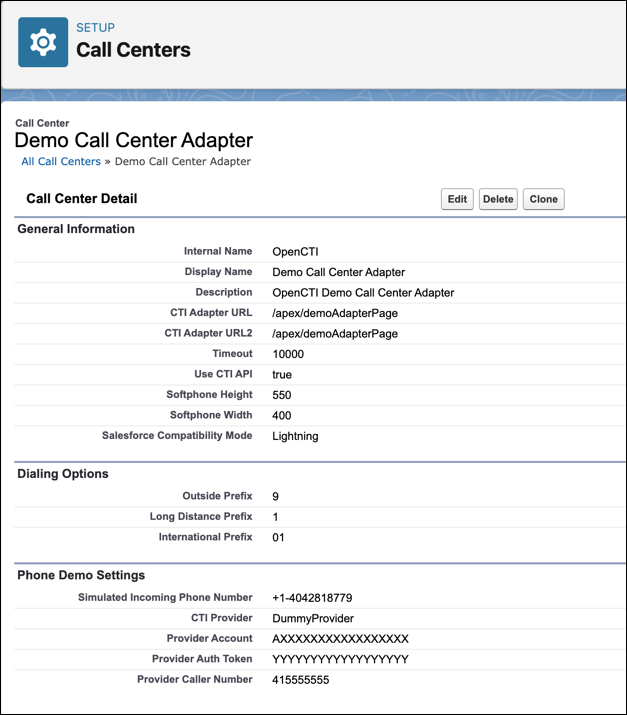
- To determine who can use the softphone, add users to the call center. You can also specify search criteria to find agents who must be assigned to the call center.

- Add a softphone to the utility bar.

- Assign the console app to all user profiles who must access it.
- Use the Engagement Connect APIs to configure the link between the softphone and an Engagement Interaction record. The link ensures that when a call comes in, it automatically creates an Engagement Interaction record.
For CTI integration steps, check out the Call Center Integration for Lightning Experience module and the Salesforce Open CTI topic.
Cindy also learns that she can configure Service Cloud Voice for partner telephony (BYOT). To learn more, see Setup Service Cloud Voice with Partner Telephony.
Discover Engagement Data Model
Engagement interaction records are better than case records for capturing the details of service communication. An engagement interaction record can relate to multiple attendees and topics, while a case is restricted to a single use and for two attendees: agent and customer.
Cindy dives into the data model to understand the three objects and the types of information they store.

The Engagement Interaction object represents information about an interaction between a service representative and the customer. Let’s look at an Engagement Interaction record.
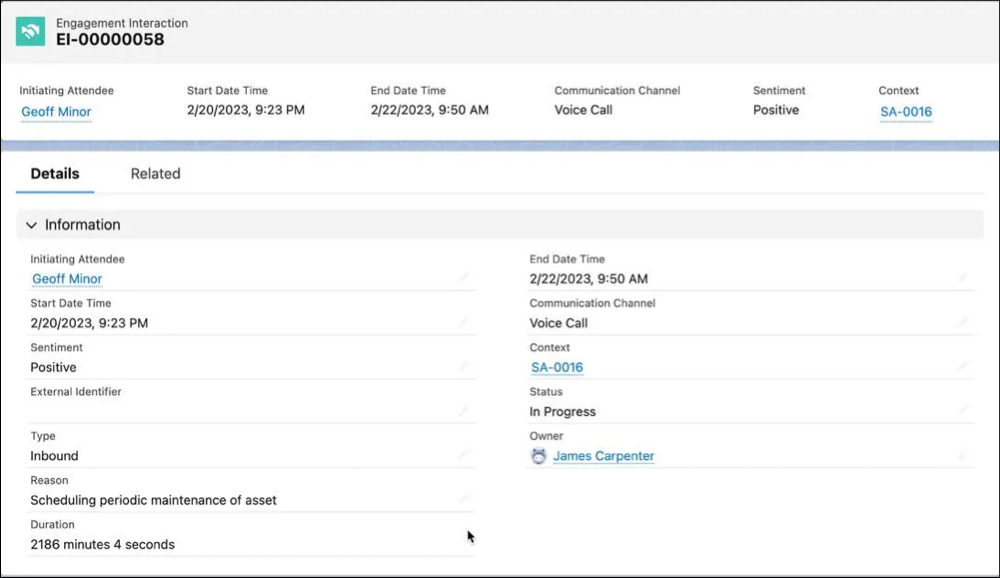
Here’s an overview of the fields and corresponding values that appear on the Engagement Interaction record.
Field |
Value |
|---|---|
Communication Channel |
Voice Call
|
Duration |
10 minutes |
Status |
In Progress |
Sentiment |
Positive |
Reason |
Scheduling periodic maintenance of asset |
Type |
Inbound
|
Context |
Service Appointment for Compactor 8000 |
Verification Time |
9:50 AM |
Attendee Verified? |
Yes |
The Engagement Attendee object represents information about the people involved in an interaction, such as the customer who has called and a support agent.
Let’s look at an Engagement Attendee record.
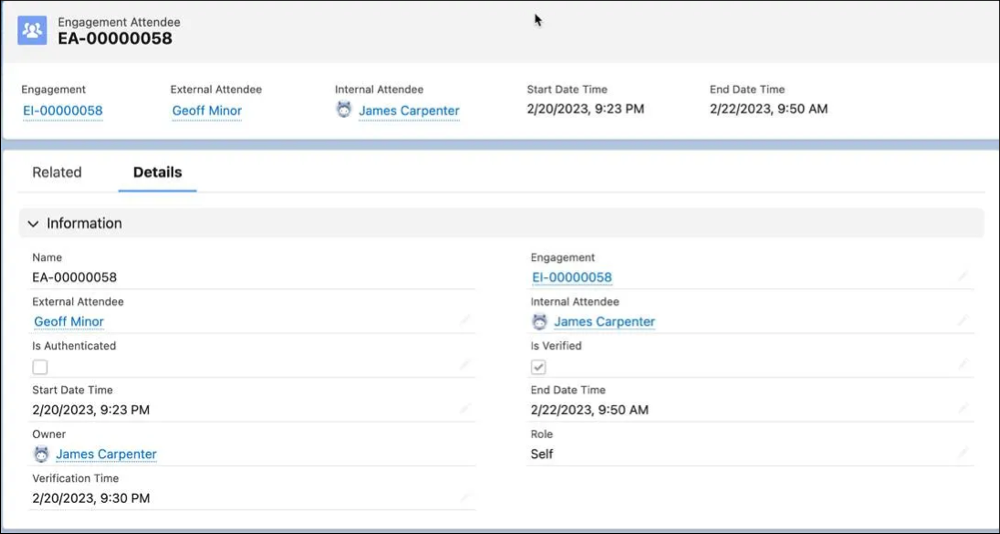
Here’s an overview of the fields and corresponding values that appear on the Engagement Attendee record.
Field |
Value |
|---|---|
Role |
Self |
Internal Attendee |
User record of the agent |
External Attendee |
Contact record of the partner |
Verification Time |
9:50 AM |
Attendee Verified? |
Yes |
The Engagement Topic object represents information about the topics discussed during an interaction. Let’s look at an Engagement Topic record.
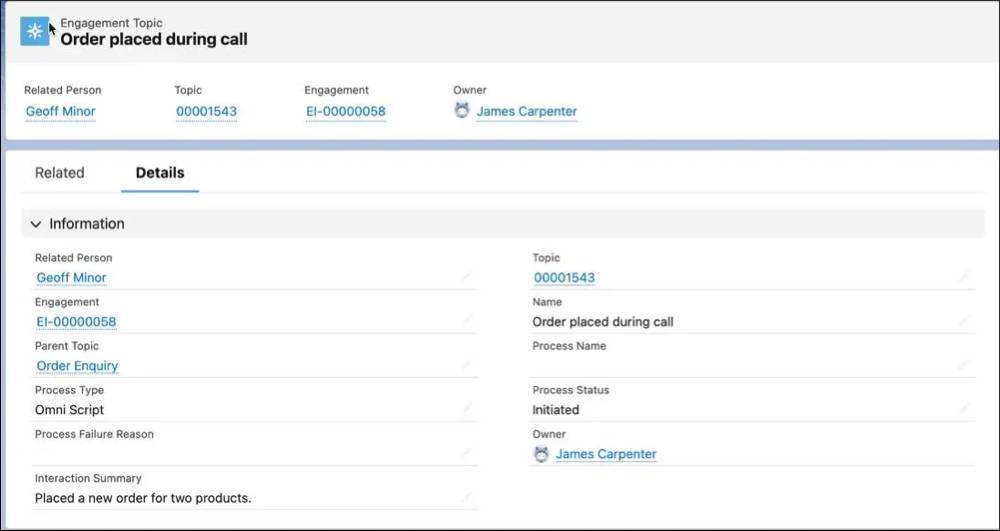
Here’s an overview of the fields and corresponding values that appear on the Engagement Topic record.
Field |
Value |
|---|---|
Topic |
Lookup to the Topic object |
Process Type |
Omni Script |
Interaction Summary |
Placed a new order for two products |
Related To |
Contact of the partner caller |
Process Status |
Completed |
Cindy moves on to the Identity Verification flow.
Get to Know Identity Verification
When you enable Service Innovations, a few Identity Verification definitions are created in the org along with a Salesforce Flow template. Cindy explores these records and the flow.
Cindy navigates to the Identity Verification Process Definition page in Setup and sees a record Sample Verification Flow. This record holds the metadata that determines the identity verification process functions.
Next, Cindy navigates to the Identity Verification Process Details page in Setup and sees the ContactSearch record. This record ensures that the agent can verify the caller details.
Cindy moves to the Identity Verification Process Field page in Setup and sees these field types related to the ContactSearch process detail record.
Field Type |
Description |
|---|---|
Search Field |
If an unregistered caller calls in, and the softphone doesn’t show their details, the agent can search by caller phone number or email address. |
Result Field |
After the agent searches for the caller, the search results show the Contact and Account records. |
Required Verifier |
The information that a caller provides must match the details shown to the agent on the identity verification screen. |
Optional Verifier |
The agent can ask the caller to confirm their phone number and email address. |
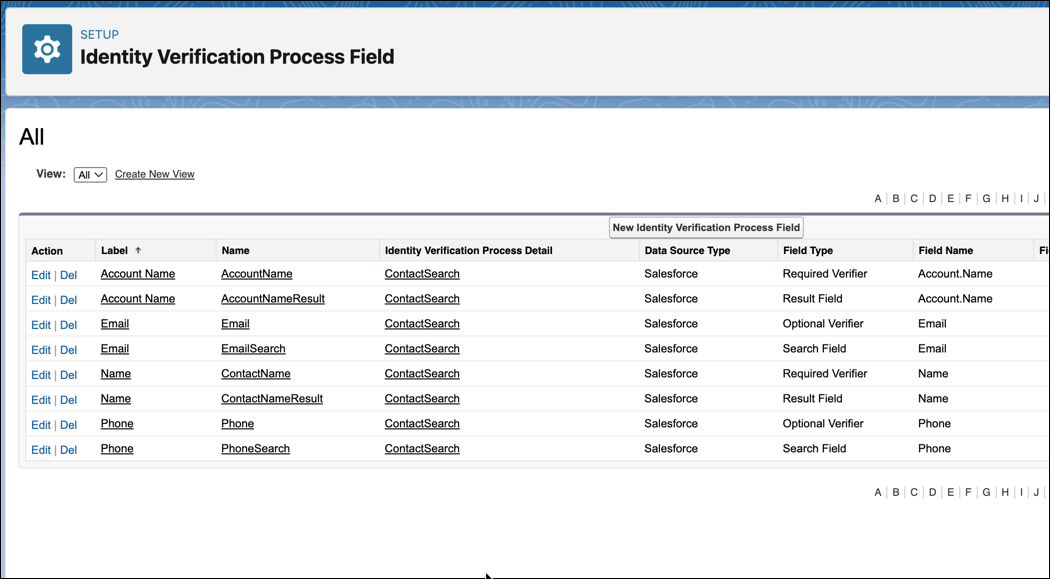
Cindy can use the guided setup on the Identity Verification Settings page in Setup to edit the predefined records that come with Service Innovations. For example, she can add Address as an optional verifier field.
Service Innovations also provides a customizable flow template Verify Customer IdentityV2 that designs the identity verification process.
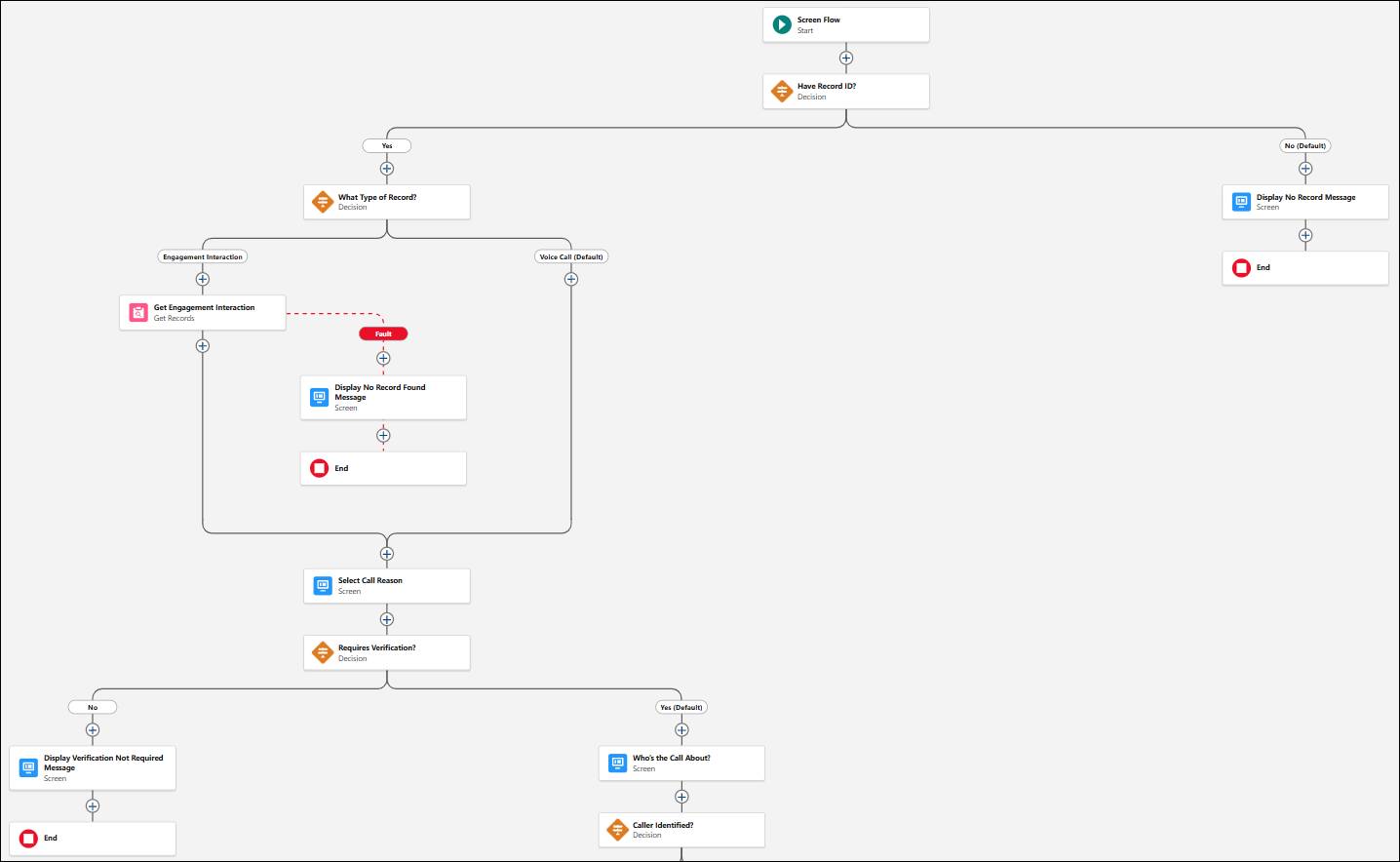
After getting familiar with Service Innovations, Cindy’s confident she’ll have a productive discussion with Najma about the new service experience roll out.
Understand Customization Requirements
Cindy meets Najma to discuss the implementation. Najma wrote down a few customization requests.
- On an account record, I want to see a timeline that shows visits, opportunities, and rebate claims.
- I want a verification question that allows the agent to select Payment Queries as the reason for a call.
- In the console, I want to see Sales Agreements, Rebate Members, and Work Orders related to the partner.
In the next unit, Cindy reviews the configurations for each feature.
Resources